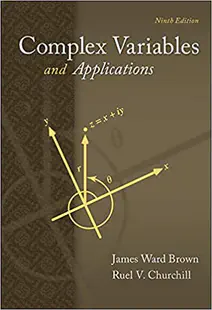General Information
List of all problems
Last Revised: 4/29/2020 Check back, will be updated over the semester.
For $z=3-2 i$, plot the following points in the complex plane: $\left\{z,-z, \bar{z},-\bar{z}, \frac{1}{z}\right\}$
Sketch these regions in the complex plane:
(a) $\operatorname{Re} z \geq 4$
(b) $|z-1-i| < 2$ .Calculate $\left|\overline{(1+i)}(2-3 i)(4 i-3)\right|$ using the simplest method possible, without multiplying out all the factors inside the modulus (hint: use properties of modulus that we learned).
Calculate the following:
(a) $\frac{1+3 i}{(2-i)^{2}}$
(b) $i^{231}+2 i^{11}-1$Solve the following equation for $z: \frac{z}{i-z}=2 i$
Which of the following statements is/are true? Explain your answers.
(a) $\operatorname{Im}(i z)=-\operatorname{Re} z$
(b) $ \operatorname{Re}(i z)=-\operatorname{Im} z $
(c) $\operatorname{Re}(w z)=(\operatorname{Re} w)(\operatorname{Re} z)$If $|z|=2$, show $8\le |z-8-6i|\le 12$.
Show that the equation $|z|=3|z-1|$ describes a circle centered somewhere along the real axis. (Hint: convert to an equation for Cartesian components $x$ and $y$ of $z=x+i y$ ).
With the principal argument given by $-\pi<$ Arg $z \leq \pi,$ find the following:
(a) $\operatorname{Arg}(-\pi)$
(b) $\operatorname{Arg}(-10 i)$
(c) $\operatorname{Arg}(-3-3 \sqrt{3} i)$For which values of $z$ is the following not true? Assume $-\pi<$ Arg $z \leq \pi$ : $\text { Arg } \bar{z}=-\text { Arg } z $
Calculate the following, expressing the result in polar/exponential form, $z=r e^{i \theta} ;$ use the polar/exponential/Euler form for all intermediate steps:
(a) $z=-8 \pi(1+i \sqrt{3})$
(b) $z=(1-i)(-\sqrt{3}+i)$
(c) $z=\frac{-1+i \sqrt{3}}{2+2 i}$Calculate the following, expressing the result in Cartesian form, $z=x+i y ;$ use the polar, aka exponential, aka Euler form for all intermediate steps:
(a) $z=i e^{i} e^{3 i \pi / 2}$
(b) $z=\frac{e^{3 i}-e^{-3 i}}{2 i}$
(c) $z=(\sqrt{3}-i)^{7}$Use the “De Moivre identity” $\cos n \theta+i \sin n \theta=(\cos \theta+i \sin \theta)^{n}$ to find trigonometric identities for $\sin 4 \theta$ and $\cos 4 \theta .$ Recall that $(a+b)^{4}=a^{4}+4 a^{3} b+6 a^{2} b^{2}+4 a b^{3}+b^{4}$
Sketch the following parametric curve: $z(t)=i+2 e^{2 i \pi t}, t \in\left[0, \frac{1}{2}\right]$ ($t$ is real)
Find the roots and plot them as points in the complex plane:
(a) $z=-2 (3-2 i)^{1/2}$
(b) $(-8 i)^{1 / 3}$Find all roots and plot them as points in the complex plane for the polynomial $z^{2}-(3-2 i) z+1-3 i=0$ Hint: this is a quadratic equation.
Sketch the set of all points satisfying $(\operatorname{Im} z)^{2}>1$ in the complex plane. Is it open or closed? Bounded or unbounded? Connected or not connected? Is it a domain?
Find the real and imaginary parts of the following functions:
(a) $f(z)=e^{z}+e^{-z}$
(b) $h(z)=\operatorname{Re}(z)+\operatorname{Im}(z)$
Hint for (a): $e^{z}=e^{x+i y}=e^{x} e^{i y}$.Find and sketch the image of a sector of the disk ${|z| \leq 2, \quad 0 \leq \text { Arg } z \leq \pi / 4}$ under the inversion mapping $f(z)=\frac{1}{z}$.
Find and sketch the image of a ring sector $\left\{z=r e^{i \theta}, 1< r< 2,0<\theta<\pi / 4\right\} $ under the mapping $w=f(z)=2+i \bar{z}^{2} .$ Use polar representation, and think of this transform as consisting of four distinct steps/operations.
Find and sketch the image of the unit circle $|z|=1$ under the mapping $f(z)=z+\frac{1}{z}$ (hint: the image of a curve is another curve)
Show that the function $f(z)= \operatorname{Arg}{z}$ is not a continuous function on the negative real axis (recall that $-\pi<\operatorname{Arg} z \leq \pi$ ). Hint: review the definition of continuity, and compare limits along different directions to any fixed point on the negative real axis.
Use the limit definition of derivative to determine whether the function $f(z)=(\operatorname{Re} z)^{2}$ is complex-differentiable anywhere it the complex plane (consider the vertical and horizontal limits for $\Delta f / \Delta z,$ as we did in class). Is it analytic anywhere? Check your answer using Cauchy-Riemann equations, $u_{x}=v_{y}, u_{y}=-v_{x}$.
Use the Cauchy-Riemann equations written in the form $\frac{d f}{d z}=\frac{\partial f}{\partial x}=-i \frac{\partial f}{\partial y}$ to show that the function $f(z)=z^{3}=(x+i y)^{3}$ is analytic in the entire complex plane, and at the same time verify that its derivative does equal $3 z^{2}$
Are the following functions differentiable anywhere? Are they analytic anywhere? Use Cauchy-Riemann equations $\left(u_{x}=v_{y}, u_{y}=-v_{x}\right)$ to answer these questions. For functions that are analytic, express them in terms of z alone (instead of $x$ and $y$ ).
(a) $g(z)=3 x^{2}+2 x-3 y^{2}-1+i(6 x y+2 y)$
(b) $h(z)=x^{3}+3 x y^{2}-3 x+i\left(y^{3}+3 x^{2} y-3 y\right)$
(c) $q(z)=e^{y} \cos x-i e^{y} \sin x$Use the usual limit definition of derivative to show that the reciprocal rule holds for complex differentiation, at all points where $f(z)$ is analytic and non-zero: $$\frac{d}{d z}\left(\frac{1}{f(z)}\right)=-\frac{1}{f^{2}(z)} \frac{d f}{d z}$$
Find all values of $z$ (if there are more than one), and graph them as points in the plane:
(a) $ z=\log (-3-3 i)$
(b) $ z=\log_0(-3-3 i) $ (By $ \log_\phi(z)$ we mean the branch of the logarithm chosen such that $\phi< \operatorname{Im}\log_\phi{(z)}\le \phi+2\pi$ with the branch in the appropriate place.)
(c) $ z=(1-i \sqrt{3})^{i}$
(d) $2 e^{z+2 i}+i=1$Use the usual chain rule to find the derivative of function $f(z)=z^{z}$ (hint: $z=e^{\log z}$.) Where is this function analytic?
Find the Cartesian components (i.e. real and imaginary parts $u$ and $v$ ) of $\sin (z)$ using only the Euler formula and the definition $\sin z=\frac{e^{i z}-e^{-iz}}{2 i} .$ Then, use the Cauchy-Riemann equations to show that $\sin (z)$ is analytic, and that $\frac{d}{d z} \sin z=\cos z$
We learned that any function analytic in some domain yields two solutions of the Laplace’s equation $\nabla^{2} \Phi=0$ in that domain. Consider Laplace’s problem in a ring (annulus) $2<|z|<3$ with the following simplest, constant boundary conditions on its two boundary circles (see Figure): $$ \begin{gathered} \Phi(r=2, \theta) \equiv \Phi\left(z=2 e^{i \theta}\right)=1 \\ \Phi(r=3, \theta) \equiv \Phi\left(z=3 e^{i \theta}\right)=2 \end{gathered} $$ Show that the real part of function $f(z)=A \log z+B$ satisfies these boundary conditions, for appropriate values of constants $A$ and $B$ (i.e. find $A$ and $B$).; therefore, it must give the solution of this problem which is the classic problem for the electric potential inside a coaxial cable or cylindrical capacitor. Note that the branch point $z=0$ is not in the domain, which is important. Why doesn’t the logarithmic branch cut spoil this solution?
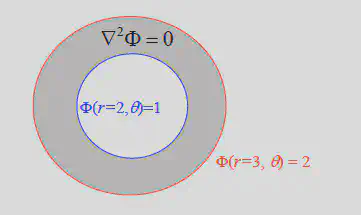
Find all values of $z$ using the definition of the corresponding inverse function in terms of exponentials, and solving the resulting equation for $e^{i z}$ or $e^{z} .$ Plot all values of $z$ in the complex plane:
(a) $z=\cos^{-1}(-1)$
(b) $z=\tanh^{-1}(2 i)$Differentiate the function $\tan^{-1} z=\frac{i}{2} \log \frac{i+z}{i-z}$ using the chain rule and simplify to obtain the familiar expression for $\frac{d}{d z} \tan^{-1} z$
Use the fundamental theorem of calculus (i.e. find the anti-derivative) to evaluate the following integrals over any contour $C$ connecting points $i$ and $-i$ in the right halfplane $(x>0) ;$ for multi-valued functions, pick the branch with $-\pi \leq \arg z<\pi$
(a) $\int_{C} z \cos \left(z^{2}\right) d z$
(b) $\int_{C} \frac{\log z}{z} d z$
(c) $\int_{C}(z+1)^{3 / 2} d z$Calculate the following contours integrals (see Figure):
(a) $\int_{C} \bar{z} d z,$ where $C_{1}$ is a piece-wise linear path (sum the integrals over the two red lines)
(b) $\int_{C_{2}} \bar{z} d z,$ where $C_{2}$ is a semi-circle of radius 1 around point $z=1$
(c) $\int_{C_3} \operatorname{Re}(z) d z,$ where $C_{3}$ is a parabola with $y=x(2-x)$
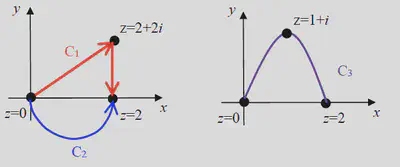
Calculate each integral, or explain why it is equal to zero. Note that all integrals are over circles of given radius. Do not use curve parametrization: use the Cauchy-Goursat Theorem and/or the Fundamental Theorem of Calculus. In (d), $\operatorname{Log} z$ denotes the principal branch with $-\pi<\arg z \leq \pi$
(a) $\oint_{|z|=1} \frac{d z}{2 z+i}$
(b) $\oint_{|z|=2} \frac{z d z}{\left(i-z^{2}\right)^{2}}$
(c) $\oint_{|z|=\frac{3}{2}} \frac{\cos z d z}{z^{2}-3 i}$
(d) $\oint_{|z|=2} \frac{d z}{\operatorname{Log} (2 z+7)}$Use Cauchy Integral Formula to calculate the following integrals. You may have to change the contour of integration into a set of closed curves surrounding each singularity inside the contour, as we did in class:
(a) $\oint_{|z|=3} \frac{\sinh z}{z^{2}+i z+2} d z$
(b) $\oint_{|z|=5} \frac{d z}{z+i z^{2}}$
(c) $\oint_{|z-1|=\frac{3}{2}} \frac{e^{z} d z}{z^{2}+i}$Use Cauchy Integral Formula (and/or its higher-order extension) to calculate the following integrals over given circles. You may have to change the contour of integration into a set of closed curves surrounding each singularity inside the contour, as we did in class:
(a) $\oint_{|z|=2} \frac{5 z^{2}+2 z+1}{(z-i)^{3}} d z$
(b) $\oint_{|z|=5} \frac{\sin z }{z^{2}(z-4)}d z$
(c) $\oint_{|z-2|=2} \frac{e^{i z} }{\left(z^{2}-1\right)^{2}} d z$
(d) $\oint_{|z+2-i|=2} \frac{z+i}{z(z+2)^{2}} d z$Find the following integral bounds over the given contour:
(a)$\left|\int_{C} \frac{z^{2} e^{i z}} {z^{3}+1}dz\right|,$ where $C$ is a straight line connecting points $z=3 i$ and $z=3$.
(b) $\left|\int_{C} \frac{\sqrt{z}}{z \log z} d z\right|,$ where $C$ is a semi-circle of radius $3$ from the point $-3 i$ to the point $3 i$ in the right half-plane; use the principal branch $-\pi<\arg z \leq \pi$ for Log $z$ and $\sqrt{z}$.Apply the Extended Cauchy Integral Formula $f^{(n)}\left(z_{o}\right)=\frac{n !}{2 \pi i} \int \frac{f(\zeta) d \zeta}{\left(\zeta-z_{o}\right)^{n+1}}$ to a circular contour $\zeta=z_{o}+r e^{i \theta}$ to obtain this relationship between function derivative at a point and circle average of the function around that point: $$f^{(n)}\left(z_{o}\right)=\frac{n !}{2 \pi r^{n}} \int_{0}^{2 \pi} f\left(z_{o}+r e^{i \theta}\right) e^{-i n \theta} d \theta.$$
Find the maxima and minima of $|f|$ and $u=\operatorname{Re} f$ for the function $f(z)=\sin z$ over the rectangle $\operatorname{Re} z \in[-\pi, \pi] ; \operatorname{Im} z \in[-\pi / 2, \pi / 2]$ (hint: $\sin z=\sin x \cosh y+i \cos x \sinh y ;$ consider separately each side of the boundary rectangle).
Use the ratio test to determine whether this series converges: $\sum_{k=1}^{\infty} \frac{(-i)^{k} k^{3}}{(1+i)^{k}}$
Use the ratio test to find the radius of convergence of these power series:
(a) $\sum_{n=1}^{\infty} n z^{n}$
(b) $\sum_{n=1}^{\infty} \frac{(-3 i)^{n} z^{n}}{n^{2}}$Prove the Taylor/Maclaurin series $\log (1-z)=-z-\frac{z^{2}}{2}-\frac{z^{3}}{3}-\ldots=-\sum_{n=1}^{\infty} \frac{z^{n}}{n}$ by explicitly calculating the derivatives $f^{(n)}(0),$ finding the corresponding expression for general $n,$ and plugging this expression for $f^{(n)}(0)$ into the series formula. Where does this series converge?
Find the first three non-zero dominant terms in the Taylor series at the given point, and state the radius of convergence of the full series by noting the distance to the nearest singularity:
(a) $f(z)=\cos z, z_{0}=\frac{\pi}{2}. \quad$ Use a shift $w=z-z_{0} \Leftrightarrow z=w+z_{0}$
(b) $f(z)=\frac{\log (1-z)}{1-z}, z_{0}=0. \quad$ Use series multiplication; see previous problem for the series $\log (1-z)$
(c) $f(z)=\sin (\sin z), z_{0}=0. \quad$ Use series composition
(d) $f(z)=\frac{e^{z}}{\cos z}, \quad z_{0}=0. \quad$ Use series divisionFind all zeros and poles, and indicate their orders:
(a) $\frac{e^{z} \sin^{3} z}{z \tanh^{5} z} $
(b) $\frac{\sin^{2} z \sinh^{3} z}{z^{2}(1-\cos z)}$.Use series differentiation to find the Taylor series for $f(z)=\frac{1}{(1-z)^{3}}$ around $z_{0}=0$
Use series integration to find the Taylor series for $f(z)=\int_{0}^{z} \exp \left(-\zeta^{2}\right) d \zeta$ around $z_{0}=0 .$ Make sure to check the integration constant.
Consider the differential equation $ \frac{d^{2} f}{d t^{2}}-t \frac{d f}{d t}-f=0$ with initial conditions $f(0)=1, , \frac{d f}{d t}(0)=0.$ Find the first several terms in the solution’s Taylor series $f(t)=1+a_{2} t^{2}+a_{4} t^{4}+O\left(t^{6}\right)$ by plugging this series into the equation, as we did in class.
Find the Laurent series for $f(z)=z^{2} \sin \frac{1}{z}$ around $z_{0}=0,$ and use term-by-term integration to determine the circle integral $\oint_{|z|=R} z^{2} \sin \frac{1}{z} d z,$ noting that only one term in this series contributes to the value of this integral.
Find the first three dominant terms in the Laurent series for $f(z)=\frac{1}{1-e^{z}}$ around $z_{0}=0$ (expand the denominator, factor out z from the denominator, and use series division/geometric series). Use term-byterm integration to determine the circle integral $\oint_{|z|=1} f(z) d z$
Find three different series representations for $f(z)=\frac{1}{z^{2}+z}$ centered at $z_{0}=1$ (not about $z_0=0$!) and indicate their domains of convergence.
Classify all singularities of the following functions:
(a) $\frac{\sin z}{z \sin \left(\frac{1}{z}\right)}$
(b) $\frac{\cos \left(\frac{1}{z}\right)}{z \cos z}$
(c) $\frac{\log (\log (z))}{z}$Find and classify all singularities inside the integration contour, calculate the residue at each singularity, and then sum the residues to compute the integral:
(a) ${\oint_{|z|=3}\frac{z^2}{8+z^{3}}}dz$
(b) $\oint_{|z|=\frac{3}{2}} \frac{d z}{(1+z)^{3} \cos z}$
(c) $\oint_{|z|=4} \frac{\cos z d z}{z^{5}}$
(d) $ \oint_{|z|=5} \frac{d z}{\sin^{3} z}$Evaluate the following integral using inversion mapping (substitution) $w=1/z$, followed by the application of the Cauchy Residue Theorem. Note that this integral can also be taken directly by calculating the residue at $z=0,$ but this would be harder than the inversion mapping method: $$ \oint_{|z|=\frac{1}{2}} \frac{\sin \left(\frac{1}{z}\right)}{z^{2}-1} d z $$
Close the contour in the upper half-plane to evaluate the following real integrals:
(a) $\int_{-\infty}^{\infty} \frac{x^{2} }{16+x^{4}}d x$
(b) $\int_{-\infty}^{\infty} \frac{\sin x }{x^{2}+x+1}dx$Close the contour in the upper half-plane to evaluate the following real integrals. Make sure to indicate which of the two integral calculations requires the use of the Jordan’s Lemma.
(a) $\int_{-\infty}^{+\infty} \frac{\cos 2 x}{x^{2}+4} d x$
(b) $\int_{-\infty}^{+\infty} \frac{x \sin 3 x}{x^{2}+2 x+2} d x$Use the “indented” contour below to finish the integral calculation that we started in class: $$\int_{-\infty}^{\infty}\left(\frac{\sin x}{x}\right)^{2} d x=\int_{-\infty}^{\infty} \frac{1-\cos (2 x)}{2 x^{2}} d x=\operatorname{Re}\left[\int_{-\infty}^{\infty} \frac{1-e^{i 2 x}}{2 x^{2}} d x\right]$$
Hint: Consider $$ \oint_{\Gamma} \frac{1-e^{i 2 z}}{2 z^{2}} d z=\int_{L_{1}} \frac{1-e^{i 2 x}}{2 x^{2}} d x+\int_{L_{2}} \frac{1-e^{i 2 x}}{2 x^{2}} d x+\int_{C_{\rho}} \frac{1-e^{i 2 z}}{2 z^{2}} d z+\int_{C_{R} } \frac{1-e^{i 2 z}}{2 z^{2}} d z=0 $$ (explain why this is zero.) NOTE: take the limit $R \rightarrow+\infty$ and $\rho \rightarrow 0^{+}$ to get the answer. The main steps are:
- First show$$\begin{aligned}&\lim_{R \rightarrow \infty, \rho \rightarrow 0^{+}}\left[\int_{L_{1}} \frac{1-e^{i 2 x}}{2 x^{2}} d x+\int_{L_{2}} \frac{1-e^{i 2 x}}{2 x^{2}} d x\right]\ =&\lim {R \rightarrow \infty , \rho \rightarrow 0^{+}}\left[\int{-R}^{-\rho} \frac{1-e^{i 2 x}}{2 x^{2}} d x+\int_{\rho}^{R} \frac{1-e^{i 2 x}}{2 x^{2}} d x\right]. \end{aligned} $$ We note that this last integral defines the principal value integral $\mathrm{P.V.} \int_{-\infty}^{+\infty} \frac{1-e^{i 2 x}}{2 x^{2}} d x$, which is what we are trying to compute)
- Then note that $\lim_{\rho \rightarrow 0^{+}}\left[\int_{C_{\rho}} \frac{1-e^{i 2 z}}{2 z^{2}} d z\right]=-\frac{2 \pi i \ {\rm{Res}}f(0)}{2}$ where $f(z)=\frac{1-e^{i 2 z}}{2 z^{2}}$.
- Show that $\lim_{R \rightarrow \infty}\left[\int_{C_{R}} \frac{1-e^{i 2 z}}{2 z^{2}} d z\right]=0.$
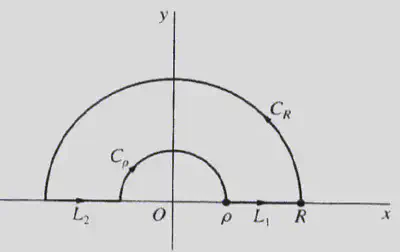
- Here’s another type of contour that is often useful. Use it to integrate $$ \mathrm{P.V.} \int_{-\infty}^{\infty} \frac{e^{\alpha x}}{1+e^x} dx = \frac{\pi}{\sin{\alpha\pi}}; \, 0<\alpha<\pi. $$ Some things to think about here:
- Where does this have poles?
- Which sides of the rectangle contribute to integral and which sides vanish in the limit $r \to \infty$?
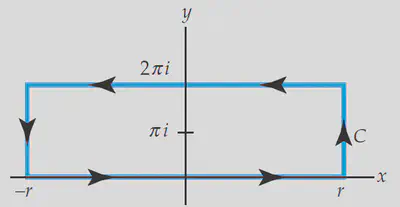
A rectangular contour.
Use the contour from the example in Section 91 to integrate $$ \int_0^\infty \frac{\sqrt{x}}{(x^2+1)^2}dx = \frac{\pi}{4\sqrt{2}}. $$
Use the methods of Section 92 to compute
- (a) $ \int_{0}^{2 \pi} \frac{1}{\cos \theta+2 \sin \theta+3} d \theta .$
- (b) $\int_{0}^{2 \pi} \frac{\sin ^{2} \theta}{a+b \cos \theta} d \theta=\frac{2 \pi}{b^{2}}(a-\sqrt{a^{2}-b^{2}}), a>b>0.$
